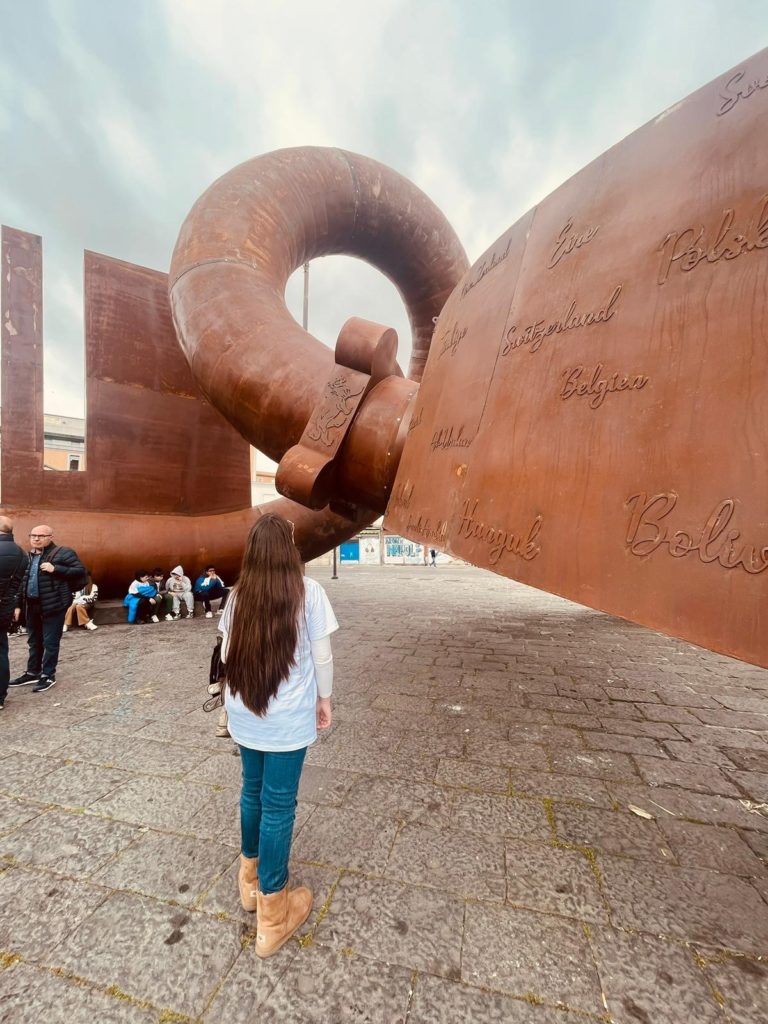
Foto di ©Roberta Colasanti
Sarà che Milot, l’autore di “Key of today”, la grande installazione in Piazza Mercato, le chiavi ha dovuto cercarle da sempre, per affermare la sua arte, per dichiarare se stesso, a spiegare il valore di questa sua opera.
Alfred Mirashi è nato nel 1969 a Milot, appunto, un piccolo villaggio non distante dal mare, poco più a nord di Tirana in Albania, un Paese, in quegli anni, così vicino e così lontano da noi. Vicino perché Durazzo è a poche miglia marine da Bari, e distante perché il duro regime comunista di Enver Hoxha per più quarant’anni l’ha tenuto lontano dall’Italia così come dal resto dell’Occidente.
Singolare, ma soprattutto disperata la sua storia che inizia presto, quando dovrà cercare chiavi per aprire il suo futuro. Suo padre era imbianchino, la madre ricamava corredi ed abiti tradizionali da sposa, quelli dai rossi smaglianti su fondi di un nero morbido e lucente. Lui, bambino, le sta vicino e prende a disegnare e a dipingere ispirato da questi lavori realizzati dalla madre.
Milot non lo sa, ma porta addosso, ereditandola, una “colpa” che non è dei padri, ma dei nonni e perfino dei bisnonni. Il giovane Alfred proviene da una famiglia di kulak, proprietari terrieri. Terminato il liceo artistico si candida per l’Accademia delle Belle Arti Albanesi di Tirana, ma non è ammesso.
Ė rifiutato: non è figlio del popolo, ma ha la “colpa” di essere il discendente di ricchi latifondisti. Lo decide una commissione di artisti del regime che, in quegli anni, dopo il “Realismo Socialista” aveva imposto il “Formalismo” che, in soldoni, stava a dire: dipingetelo con la forma che preferite (cubismo, futurismo, fauvismo, espressionismo…) ma lodate il regime ed Enver Hoxha che ne è il profeta.
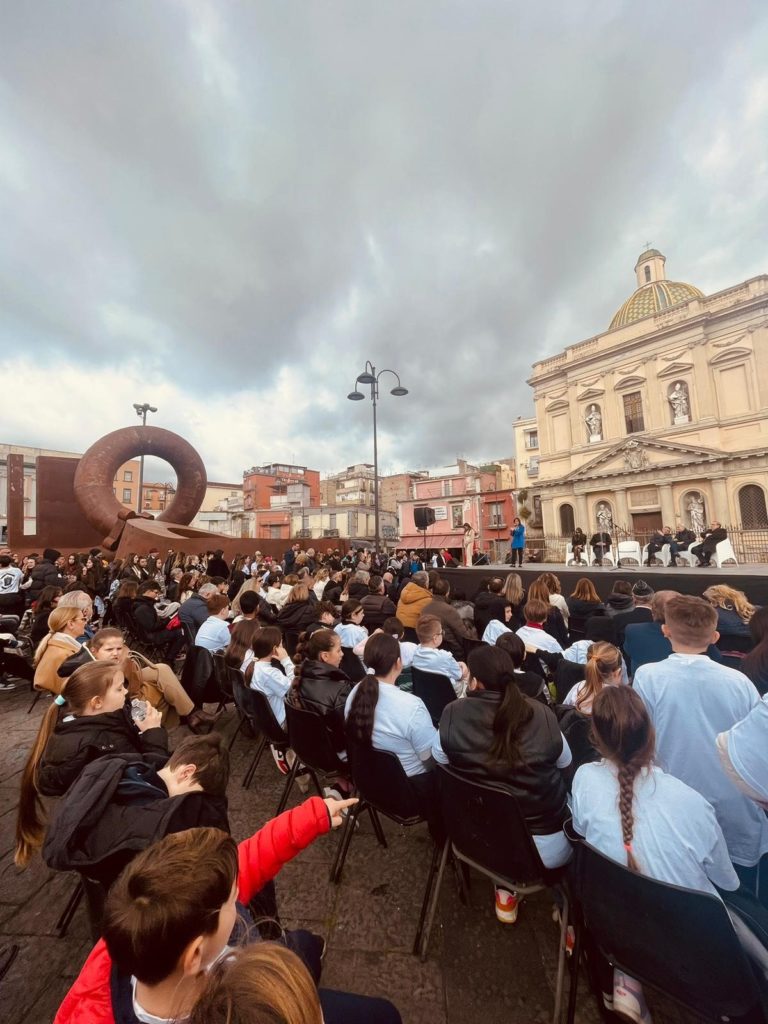
Al giovane deluso resta una sola via, una sola chiave: fuggire dal martoriato e orgoglioso Paese delle Aquile. Si imbarca con altri disperati nella prima “carretta di mare” che portò il 7 marzo 1991 a Brindisi oltre seimila profughi albanesi.
Alfred era con loro, con un piccolo fagotto in cui aveva messo speranza, determinazione ed il nome del suo paesino, Milot. E da qui inizia la sua crescita umana e artistica. La sua formazione è tutta italiana: «Lo è soprattutto quella visiva – ebbe modo di dichiarare anni dopo – perché è soltanto in Italia che ho potuto vedere i grandi maestri e studiarli. Qui ho trovato le librerie, i musei, le gallerie. Al liceo non ho mai visto un libro d’arte. In Italia invece tutto mi veniva offerto su un piatto d’argento.» Milot ha un precedente storico: prima di lui un altro artista albanese, Ibrahim Kodra, aveva scelto la “chiave Italiana” per esprimere la propria arte.
Milot è così a Napoli, poi a Prato e la vicinanza con Firenze gli fa conoscere il nostro Rinascimento, infine, facendo mille mestieri, approda a Milano e a Brera può coronare il sogno: iscriversi all’Accademia delle Belle Arti. La “chiave” della fuga aveva aperto finalmente la possibilità di manifestarsi e poi di affermarsi.
C’è tutto questo dietro la monumentale chiave alta 10 metri che per tre mesi sarà lì nella Piazza del Mercato, lo spazio storico delle passioni, degli affanni, delle tragedie e delle illusioni di Napoli. L’installazione è stata inaugurata giovedì scorso, presenti, tra gli altri, il sindaco Gaetano Manfredi, lo scrittore Maurizio de Giovanni, l’ambasciatrice albanese in Italia, Anili Bitri Lani e Michael Kaiser in rappresentanza dello sponsor Jean Wolf Company che ha prodotto l’opera.
E dire che per Milot non è stata questa la prima volta a Napoli. Nel 2003 è protagonista al Maschio Angioino con la personale “Le Veneri di Milot” che stabilisce un punto fermo nella sua ricerca concettuale e stilistica. Propose una serie di grandi tele, denominate “Angolo del Mediterraneo”, sulla contaminazione fra la cultura popolare albanese (in particolare proprio quelle texture dei vestiti tradizionali albanesi, ricordando la madre) e la memoria storica del Mediterraneo.
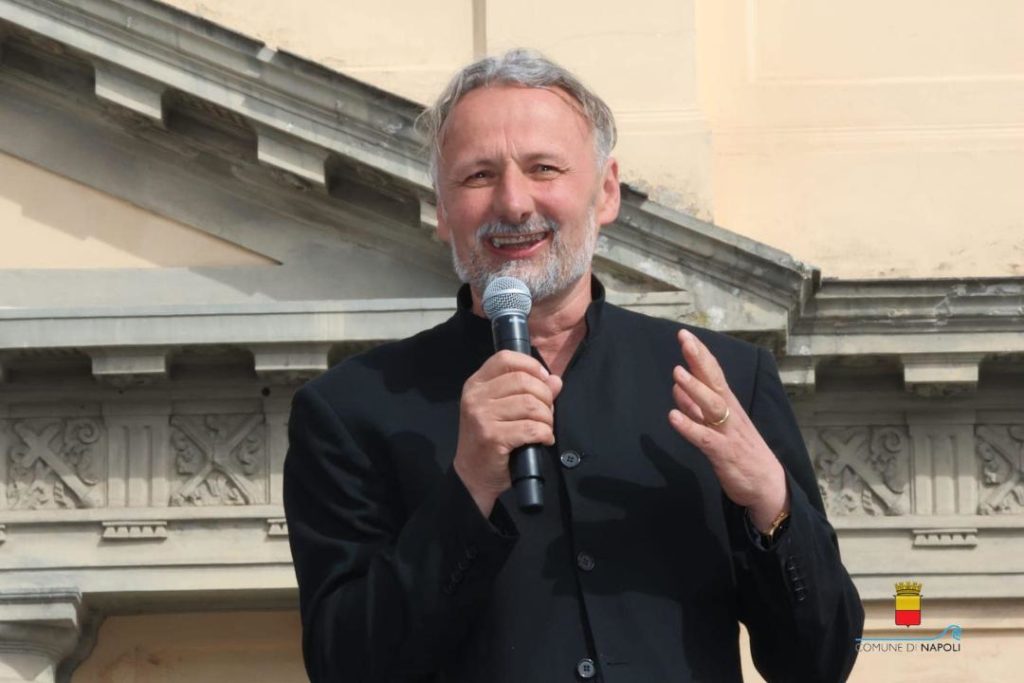
“Key of today”, significa appunto la “chiave di oggi” che racchiude però un breve ma intenso passato. Rifuggiamo la semplicistica retorica della chiave che apre. Le chiavi chiudono anche. Le chiavi proteggono. In una città come Napoli (ma non soltanto Napoli, quanto più esattamente nell’intera società) le chiavi, girando in senso antiorario nella serratura delle menti e dei cuori, aprono al dialogo, all’incontro e al confronto con il prossimo. Ma nello stesso meccanismo, girando questa volta in senso contrario, chiudono alle violenze, alle paure, ai razzismi, alle incomprensioni, ai dolori, alle guerre, alle sopraffazioni.
La chiave di Milot di Piazza Mercato è contorta, come se, chiudendo o aprendo, abbia dovuto forzare la serratura così che s’è attorcigliata. E pare un essere vivente, provato, dolente, accasciato a terra come in cerca di riposo, esausto ma trionfante per aver assolto la sua funzione: apre/chiude.
©Riproduzione riservata
Piazza del Mercato/ Milot’s key closes to violence. That Albanian artist who began his human and creative growth in Italy
It may be that Milot, the author of “Key of today,” the large installation in Market Square, has always had to look for the keys, to affirm his art, to declare himself, to explain the value of this work of his. Alfred Mirashi was born in 1969 in Milot, precisely, a little village not far from the sea, just north of Tirana in Albania, a country, in those years, so near and so far from us.
Close because Durres is only a few nautical miles from Bari, and distant because the harsh communist regime of Enver Hoxha for more than forty years kept him far from Italy as well as from the rest of the West. Singular, but above all desperate, is his story that begins early, when he will have to search for keys to open his future. His father was a house decorator, his mother embroidered trousseaus and traditional wedding dresses, those with dazzling reds on backgrounds of soft, shiny black. He, a child, stays close to her and takes to drawing and painting inspired by these works made by his mother.
Milot does not know it, but he carries on him, inheriting it, a “guilt” that is not of his fathers, but of his grandfathers and even great-grandfathers. Young Alfred comes from a family of kulaks, landowners. After finishing art high school, he applies for the Albanian Academy of Fine Arts in Tirana, but is not admitted. He is rejected: he is not a son of the people, but is “guilty” of being the descendant of wealthy landowners. This is decided by a commission of artists of the regime, which, in those years, after “Socialist Realism” had imposed “Formalism,” which, in a nutshell, stood for: paint him in the form you prefer (Cubism, Futurism, Fauvism, Expressionism…) but praise the regime and Enver Hoxha who is its prophet.
The disillusioned young man is left with only one way, only one key: escape from the battered and proud Land of Eagles. He embarks with other desperate people on the first “sea carriage” that brought more than six thousand Albanian refugees to Brindisi on March 7, 1991. Alfred was with them, with a small bundle in which he had put hope, determination and the name of his village, Milot.
And from here began his human and artistic growth. His training is all Italian: “It is especially the visual one,” he had occasion to declare years later, “because it was only in Italy that I was able to see the great masters and study them. Here I found the bookstores, the museums, the galleries. In high school I never saw an art book. In Italy, on the other hand, everything was offered to me on a silver plate.” Milot has a historical precedent: before him another Albanian artist, Ibrahim Kodra, had chosen the “Italian key” to express his art.
Milot is thus in Naples, then in Prato and the proximity to Florence introduced him to our Renaissance, finally, doing a thousand trades, he lands in Milan and in Brera he can crown his dream: to enroll in the Academy of Fine Arts. The “key” to escape had finally opened the possibility of manifesting himself and then establishing himself.
There is all this behind the monumental 10-meter-high key that for the next three months will be there in the Piazza del Mercato, the historic space of Naples’ passions, afflictions, tragedies and illusions. The installation was unveiled last Thursday, attended by, among others, Mayor Gaetano Manfredi, writer Maurizio de Giovanni, Albanian Ambassador to Italy Anili Bitri Lani and Michael Kaiser representing sponsor Jean Wolf Company, which produced the work.
It is worth saying that this was not Milot’s first time in Naples. In 2003 he was the protagonist at the Maschio Angioino with the solo show “Le Veneri di Milot” that established a milestone in his conceptual and stylistic research. He proposed a series of large canvases, called “Corner of the Mediterranean,” on the contamination between Albanian popular culture (particularly precisely those textures of traditional Albanian clothes, remembering his mother) and the historical memory of the Mediterranean.
“Key of today,” means in Italian ” la chiave di oggi” which nevertheless encompasses a brief but intense past. We reject the simplistic rhetoric of the key that opens. Keys also close. Keys protect. In a city like Naples (but not only Naples, how much more exactly in the whole society) keys, turning counterclockwise in the lock of minds and hearts, open to dialogue, encounter and confrontation with others. But in the same mechanism, turning this time in the opposite direction, they close to violence, fears, racism, misunderstandings, sorrows, wars, and oppression.
Milot’s key in Piazza del Mercato is twisted, as if, closing or opening, he had to force the lock so that it twisted. And it looks like a living being, tried, aching, slumped on the ground as if seeking rest, exhausted but triumphant for having fulfilled its function: opening/closing.


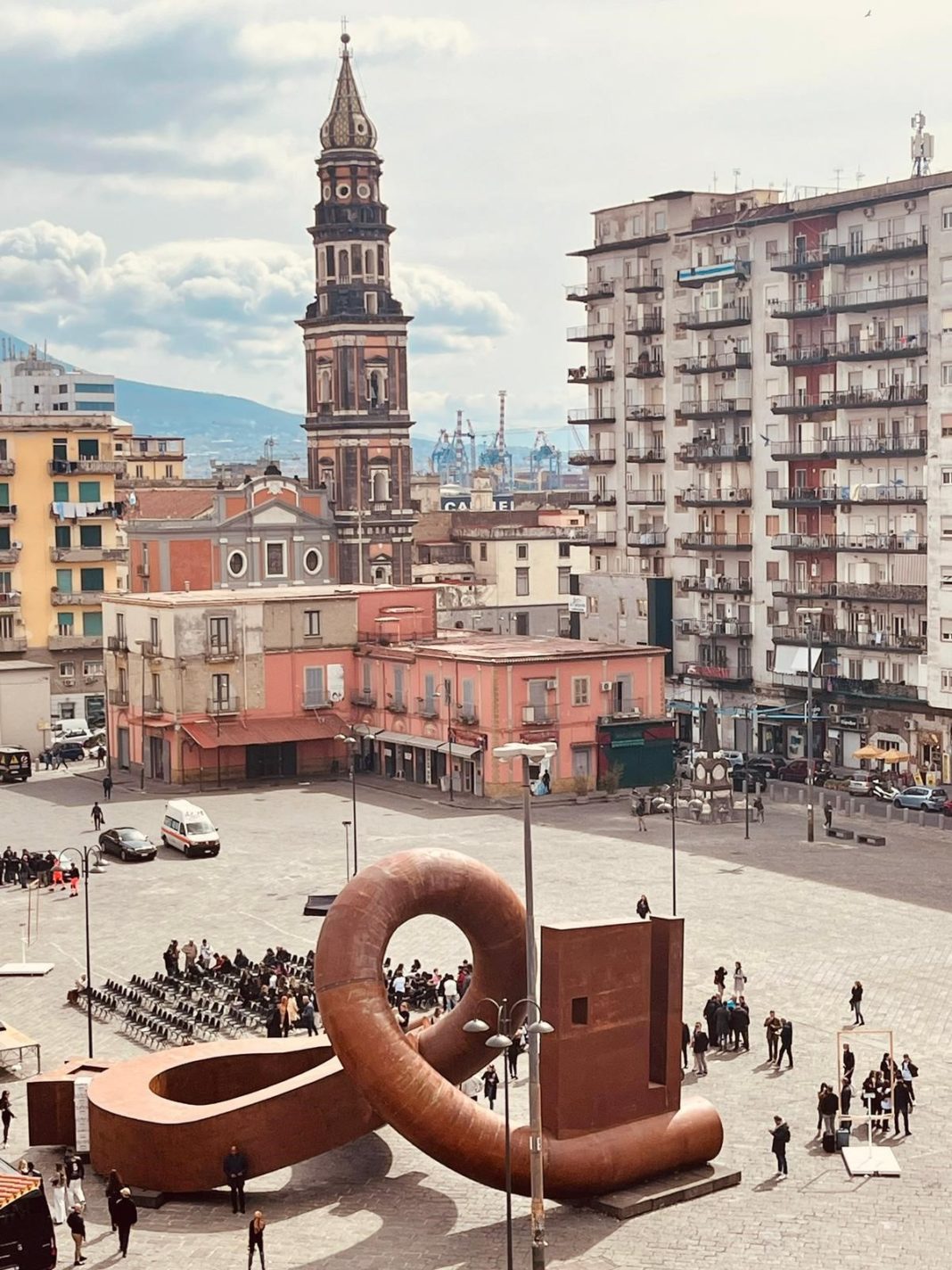
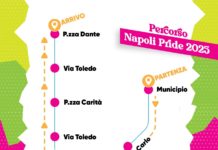
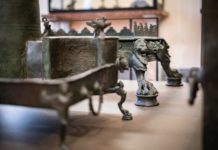






[…] Qui sopra, l’installazione dell’artista albanese Milot che lo scorso anno per alcuni mesi è stata proposta in piazza del mercato […]